Canada is a beautiful country and trees cover at least 40% of its land. There are heavy forests and woods in Canada with tall trees that offer shade and refuge to many animals. Canada is home to hundreds of shrubs and trees, with many differences. Trees are important to Canada’s unique environment. But which tree species is the tallest, and what other massive trees are native to this country?
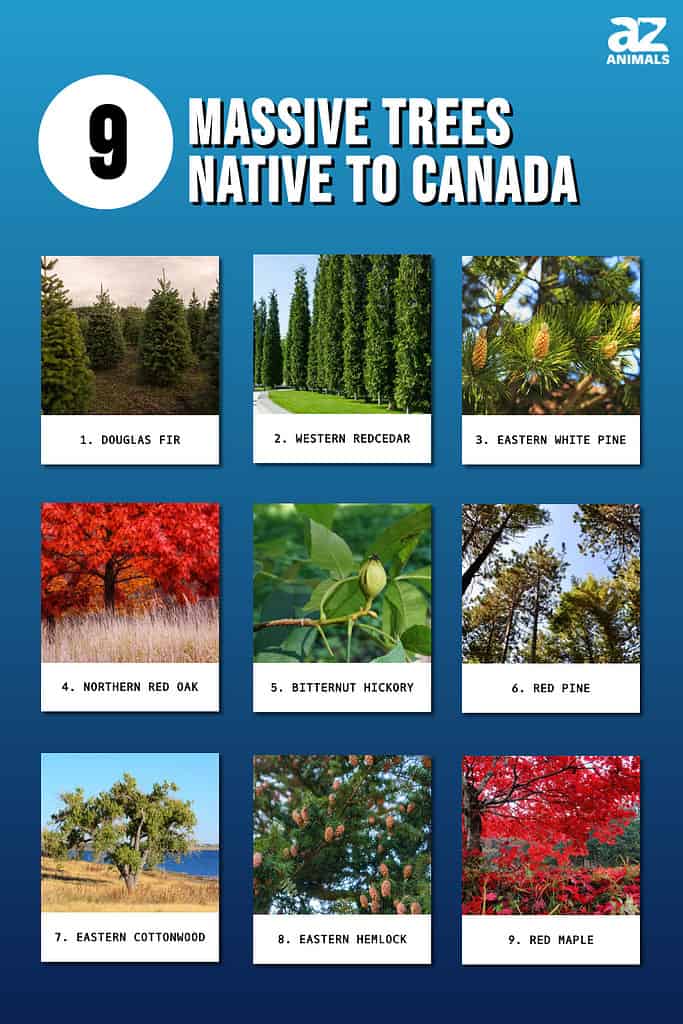
Keep reading to learn more about nine massive trees native to Canada.
1. Douglas Fir
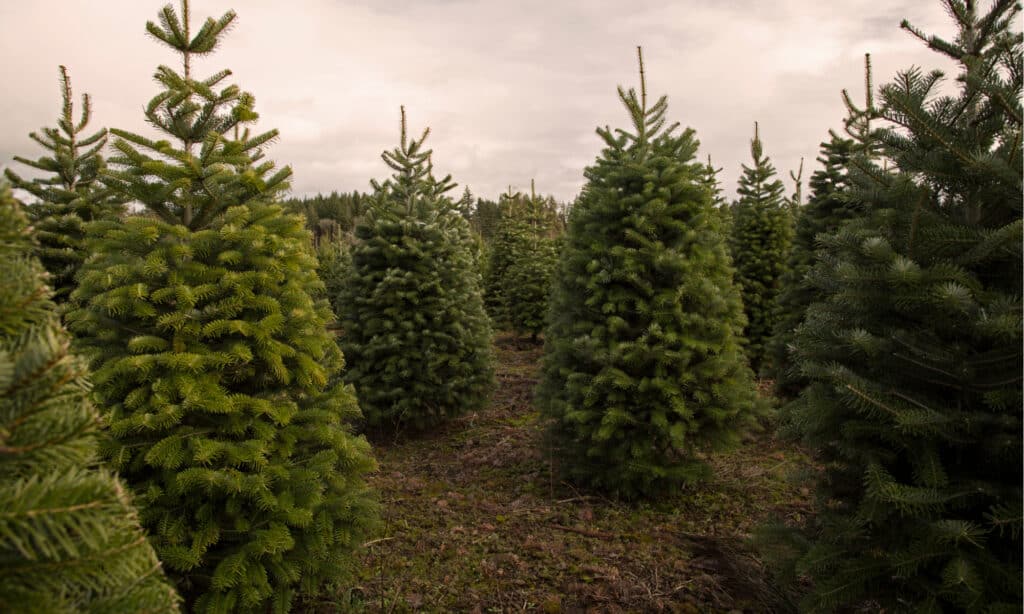
Douglas firs can sometimes reach heights of over 330 feet.
©Jacquie Klose/Shutterstock.com
One of the most common trees in Canada is the Douglas fir, also written as Douglas-fir or called Oregon pine. This tree species is native to parts of Mexico, Canada, and the United States. It is a beautiful and extremely large tree, sometimes reaching impressive heights of over 330 feet. Many Douglas-fir trees live over 500 years old, while some reach 1,300 years. The oldest Douglas-fir tree in Canada is well over 1000 years old. The largest Douglas-fir in the world by volume is also found in the San Juan Valley of Vancouver Island in British Columbia, Canada. Scientists estimate this tree was seeded around 1000 CE. It sits less than a mile from the San Juan River and has an impressive diameter of 14 feet. This tree stands at 242 feet, with a circumference of 32 feet. Animals rely on Douglas-fir seeds as a food source, specifically chipmunks and moles.
2. Western Redcedar

The western red cedar is an evergreen coniferous tree in the cypress family, Cupressaceae.
©Marinodenisenko/Shutterstock.com
Another tree native to Canada and found throughout the country’s many forests is the western redcedar. This tree is native to the Pacific Northwest of North America and is sometimes called the Pacific red cedar, shinglewood, and giant cedar. These shade-tolerant trees reach impressive heights. For example, some western redcedars reach over 230 feet tall. They are one of the larger trees in their genus, thuja. Western redcedar trees produce slender cones, less than an inch long with 8 to 12 overlapping scales. The cones ripen about 6 months after fertilization and turn brown. These trees thrive near the coast in moist and wet conditions. Western redcedar trees are often used by many bird species when building their nests. For example, you can spot yellow-bellied sapsuckers, hairy woodpeckers, Vaux’s swifts, and tree swallows nesting in western redcedars.
3. Eastern White Pine

Reaching up to 180 feet tall, eastern white pines are popular worldwide.
©Ukrolenochka/Shutterstock.com
While eastern white pine trees aren’t the largest native trees in Canada, they still reach amazing heights. Most eastern white pine trees grow between 100 to 150 feet. However, taller trees were reported prior to exploitation. Eastern white pines are common in Ontario. They are the tallest tree in the region. However, you can also find them as south as northeastern Alabama and northernmost Georgia. These coniferous trees produce bluish-green thin and flexible needles. They typically live between 200 to 250 years, but scientists estimated one of the oldest eastern white pine trees to be at least 500 years old. Interestingly, some small live eastern white pine trees are sold as Christmas trees since they hold their needles well.
4. Northern Red Oak
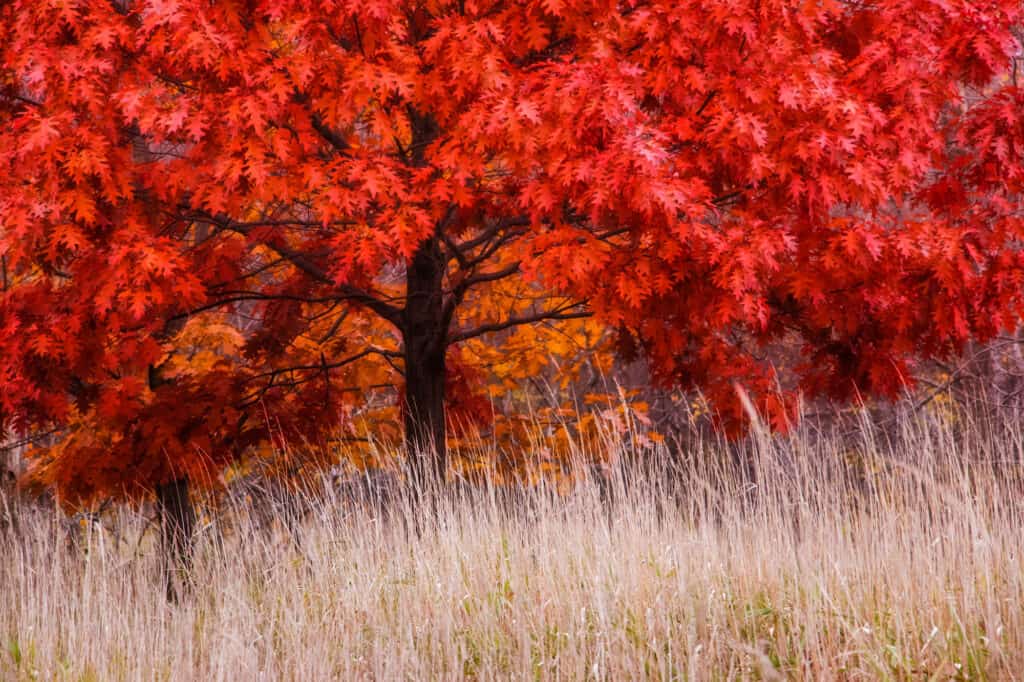
The red leaves northern red oak trees produce are stunning.
©iStock.com/Jean Landry
Although northern red oak trees have been introduced to small parts of Europe, this tree species is native to North America, specifically in the eastern and central United States and southeast and south-central Canada. Northern red oak trees are beautiful and produce stunning red leaves as the seasons change. It’s a tall deciduous tree. The average northern red oak tree reaches about 92 feet tall, but higher trees have been recorded. They thrive in full sun and grow quickly. A tree as young as 10 years old can reach 20 feet tall. Northern red oak trees suffer from pests and diseases. Diplodia corticola, a tough fungus, has led to many northern red oak tree deaths. One of the oldest northern red oak trees in Toronto, Zhelevo, is 79 feet tall and over 250 years old.
5. Bitternut Hickory

Pollinated by wind, bitternut hickory trees produce catkins that develop into small, bitter nuts.
©Plant Image Library from Boston, USA, CC BY-SA 2.0 <https://creativecommons.org/licenses/by-sa/2.0>, via Wikimedia Commons – License
Next on our list is the bitternut hickory, native to some parts of Canada, including southern Quebec and west to southern Ontario. Bitternut hickory trees are also found throughout the eastern United States. These trees have large vibrant green leaves and live for about 200 years. On average, bitternut hickory trees are 115 feet tall, but some have grown past 154 feet. The leaves are about 6 to 12 inches long and the trunk’s diameter can be as thick as 3 feet 3 inches. These trees produce wind-pollinated catkins, which develop into small and bitter nuts. Bitternut hickory trees are close relatives of the pecan, but the nuts are not edible. These trees are especially common in swamps and wetlands. Bitternut hickory wood also has many uses since it’s strong and durable. You can use the wood for furniture and smoking meat.
6. Red Pine
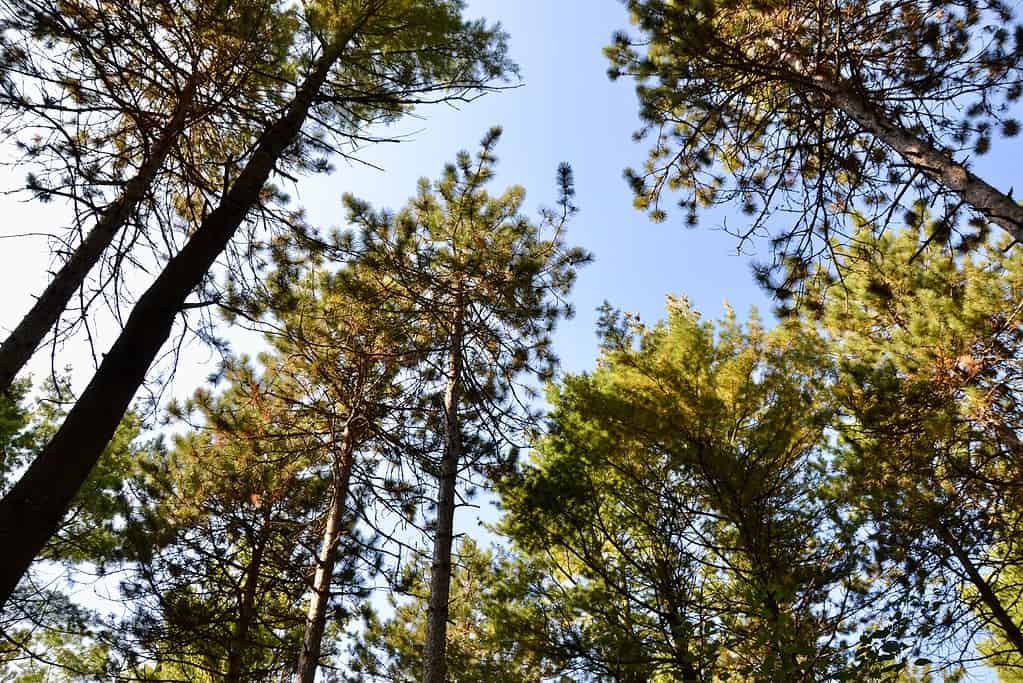
While most grow to around 115 feet tall, red pine trees can reach up to 140 feet.
©Chris Dale/Shutterstock.com
Red pine trees are also native to Canada. They are tall coniferous evergreen trees that grow straight up. Usually, red pine trees grow up to 115 feet tall, however, large specimens over 140 feet have been recorded. In Minnesota, red pine trees, are also called Norway pine trees. This is because of the many Scandinavian immigrants that moved to Minnesota and compared the red pine trees to the Scots pines they were familiar with. Unlike other trees, red pine needles are yellow-green. The leaves are thin and snap cleanly went bent. Although not as common, red pine trees also grow in the Appalachian Mountains in Virginia and West Virginia. Red pine trees are also old, some reaching up to 500 years of age.
7. Eastern Cottonwood
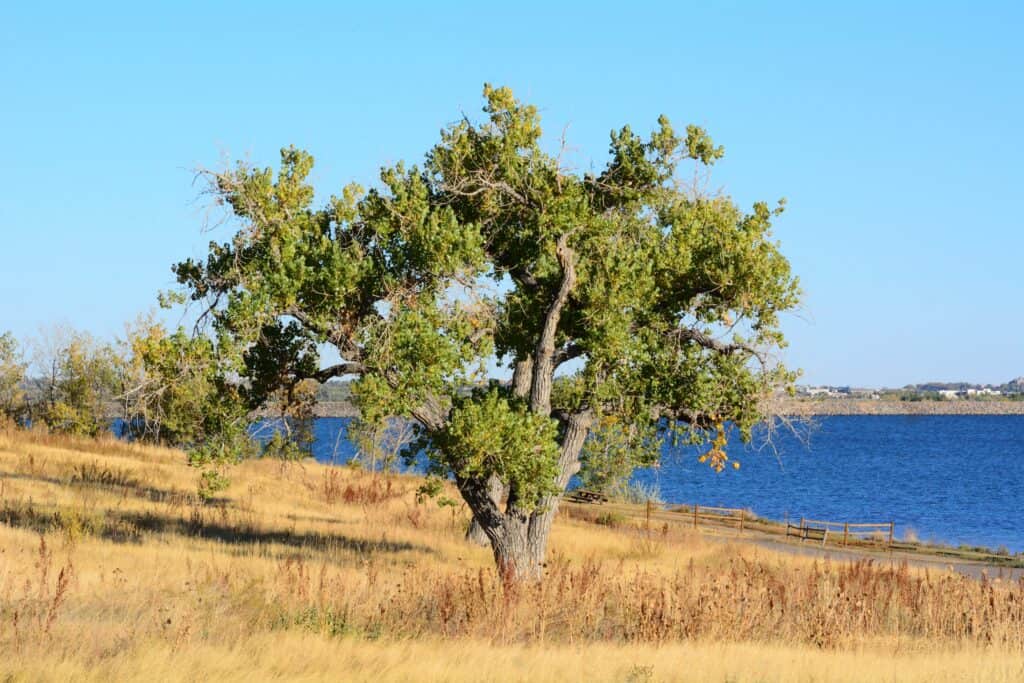
While they mainly grow in the United States and Mexico, eastern cottonwood trees also grow in southern Canadian prairies.
©Merrimon Crawford/Shutterstock.com
Eastern cottonwood trees, also known as necklace poplars, are native to North America. While they are mainly found in the United States and Mexico, they also grow in the southern Canadian prairies and the southernmost part of eastern Canada. These trees easily reach about 100 feet tall. The bark is unique, silver, and smooth. Eastern cottonwood trees are fast growers, sometimes growing about 10 to 15 feet in a year for their first few years of life. There are also about three subspecies of five varieties of eastern cottonwood trees. The subspecies most commonly found in Canada is the Populus deltoides subsp. deltoides.
8. Eastern Hemlock
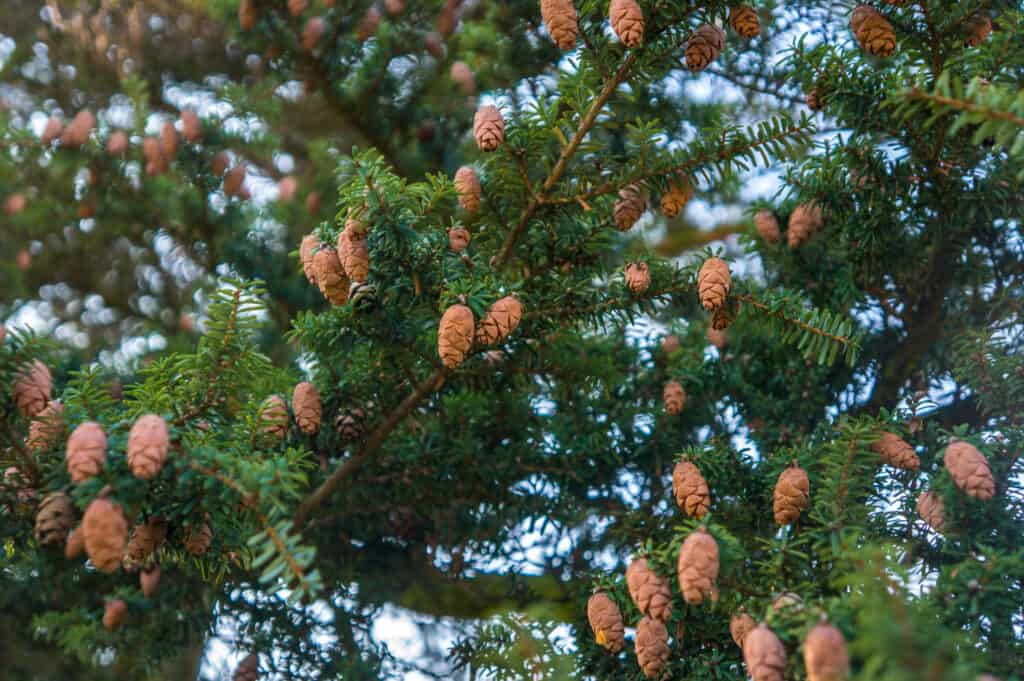
Hemlock trees can endure heavy snowfall and even ice storms
©iStock.com/Sara Lissaker
Another common native tree in Canada is the eastern hemlock tree. It’s sometimes also referred to as the Canadian hemlock or eastern hemlock spruce. Eastern hemlocks are coniferous trees that grow in some parts of Canada, like Maritime Canada. Apart from Canada, you can also find eastern hemlock trees throughout the United States. They are very common in Pennsylvania, so common that they are the state’s official tree. Eastern hemlock trees are near threatened. They are being killed in their native range by the invasive Hemlock woolly adelgid, an insect native to East Asia. These trees are very tall and old. The oldest found specimen is recorded to be at least 554 years old. They are thick trees with diameters as large as 4 feet 11 inches.
9. Red Maple
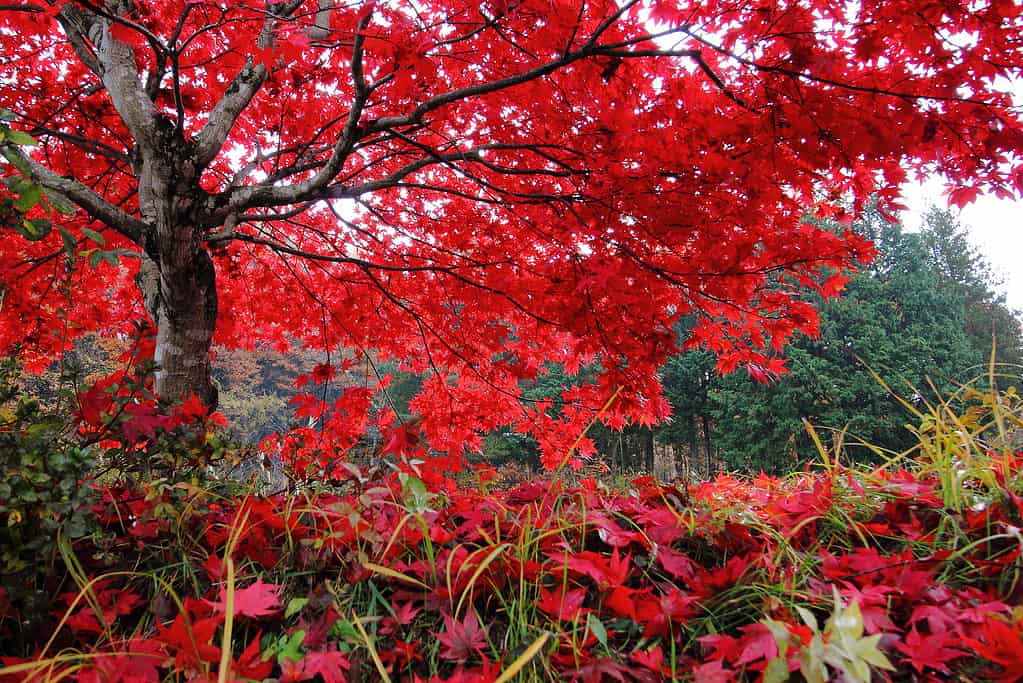
The most distinguishing feature of red maple trees is their lovely red foliage.
©KungChuyada/Shutterstock.com
Last but not least is the red maple tree. This tree is native to eastern and central North America. They are best known for their beautiful and vibrant fall foliage. Red maple trees are abundant and hardy trees. They are found as south as Florida. These trees are tall, with most trees reaching about 90 to 120 feet. However, red maple trees as tall as 130 feet aren’t uncommon. Red maple trees are heat- and cold-tolerant. While most red maple trees live about 100 years, their maximum lifespan is 150. Not only are they widespread, but many places plant red maple trees for a burst of color during autumn. These trees are so popular that there are multiple cultivars, mainly ranging in the color of the leaves. Interestingly, red maple tree leaves are toxic to horses. Sadly over half of the horses affected by the toxin in the leaves die.
The photo featured at the top of this post is © iStock.com/Jean Landry
Thank you for reading! Have some feedback for us? Contact the AZ Animals editorial team.






